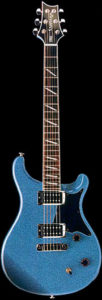In 2001, Paul Reed Smith introduced the affordably-priced Santana SE guitar; within a year or two, they made some changes in the specifications. Though the company made no distinction in the model name, most people know “phase two” as the Santana SE II model: a slight variation on the theme.
 Santana SE Guitar Series
Santana SE Guitar Series
Many of the differences between the guitars known to the world at large as the Santana SE and Santana SE II guitars were probably in response to player requests; others may have been due to the changing costs and availability of parts and materials.
For instance, the first models were originally produced in Japanese factories; later, the manufacturing was moved to Korea. Pickups were first covered, then uncovered (or “open coil”), pickguards appeared after the first year, different colors and finishes were available in later years, etc.
But one of the definite distinctions between the two SE models is that the Santana SE II guitars have binding around the neck and fretboard in a contrasting color. Combined with the sparkle finishes available in the SE II models, they have more of a “heavy metal” look than the original version.
 Part Santana, Part PRS
Part Santana, Part PRS
 Both models have the asymmetrical body shape, with greatly reduced carving (on only the lower horn). For the PRS Santana SE II, a pickguard was introduced — something none of the Santana Signature models have.
Both models have the asymmetrical body shape, with greatly reduced carving (on only the lower horn). For the PRS Santana SE II, a pickguard was introduced — something none of the Santana Signature models have.
The neck remained a 25″ scale length with 22 frets, and still had the “Santana wide fat” shape, complete with 10″ radius. And, of course, the fretboard is Rosewood, though the white binding gives it a distinct look
Still providing the famous Paul Reed Smith tone is the resonant Mahogany body, renowned for it’s thick, Les Paul-like sound without the overbearing weight.
 Hardware and Electronics
Hardware and Electronics
Akin to all the rest of the Santana Signature models (except the original in the series), both SE guitars feature two humbucking pickups, and controls include a Volume knob, Tone knob, and 3-position pickup selector switch. The pickups, besides being open-coil on the Santana SE II guitar, may have a slightly beefier sound.
Like the First Santana SE guitar, the SE II model was available with a choice of PRS tremolo or PRS stop-tail bridge. Even on the tremolo-equipped models, though, the tuners are non-locking — which causes tuning problems with aggressive use of the tremolo.
 Sound and Feel
Sound and Feel
By all reports, the Santana SE II feels and sounds at least as good as the model from which it evolved, with a rich tone and good, solid feel far beyond what one might expect from such a reasonably priced guitar.
If want the exact model played by Carlos Santana, the Santana SE series isn’t for you. However, for a dependable, road-worthy workhorse, you’d be hard pressed to find a better value: roughly $350 – $400, used (PRS stopped offering them around the middle of 2007).
PRS Santana SE II Colors: Finishes available: Aqua Metallic, Pearl White, Royal Blue, Silver, Tobacco Sunburst, Vintage Cherry


